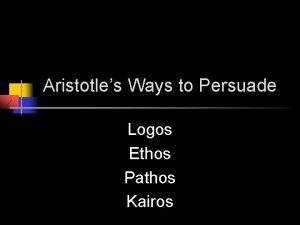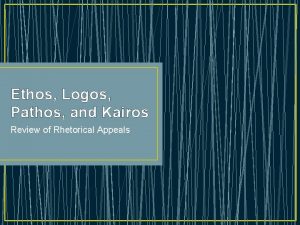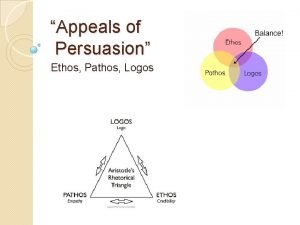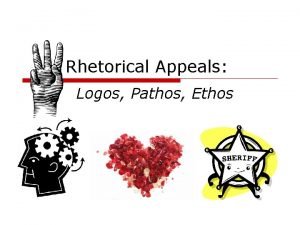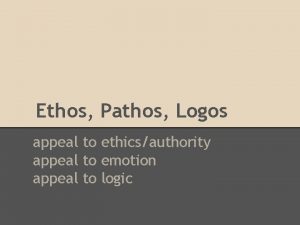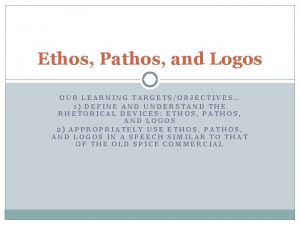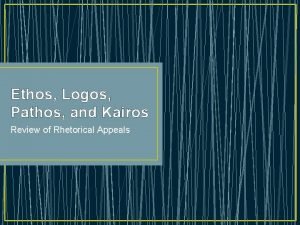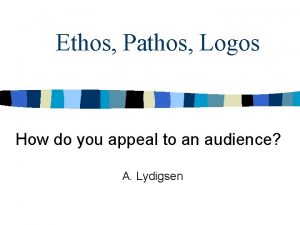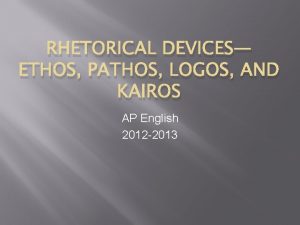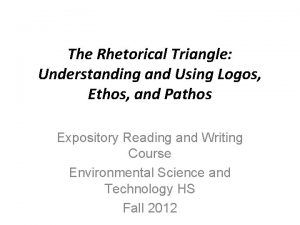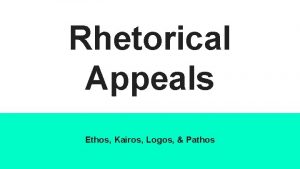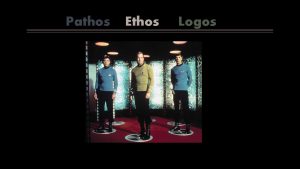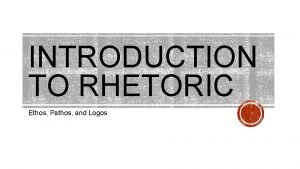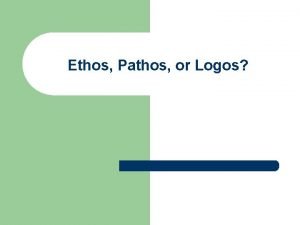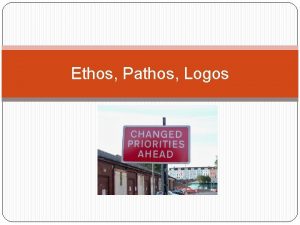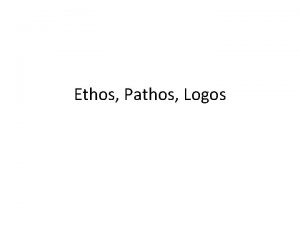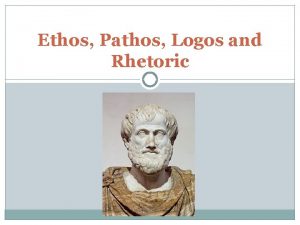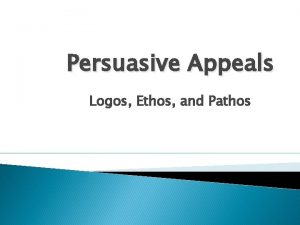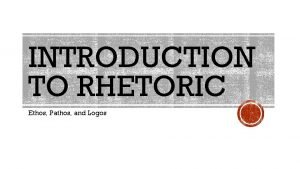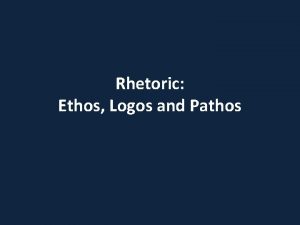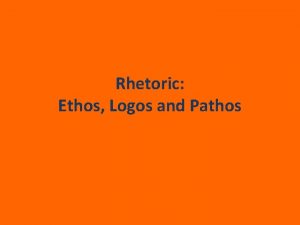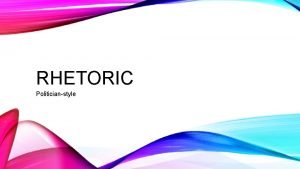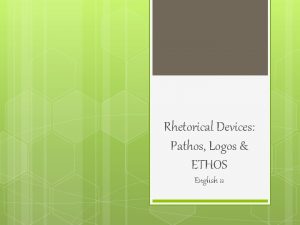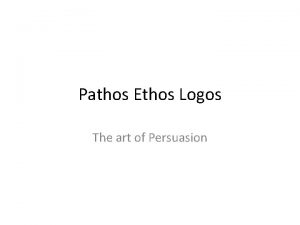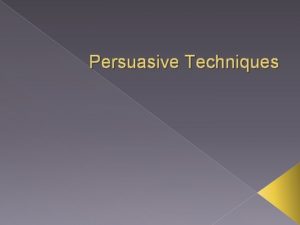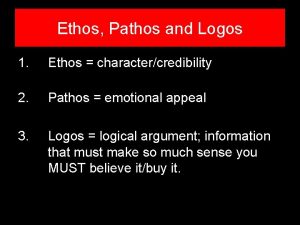INTRODUCTION TO RHETORIC Ethos Pathos and Logos LETS


















- Slides: 18

INTRODUCTION TO RHETORIC Ethos, Pathos, and Logos

LET’S START AT THE VERY BEGINNING Rhetoric is: ▪ SITUATED COMMUNICATION (rhetorical situation) ▪ Communication in some context ▪ The art of speaking or writing effectively and persuasively in a particular context (context = a social space, i. e. , classroom, work environment, dinner gathering) ▪ Forms of communication that are shaped by a particular social situation

ARGUMENT VS PERSUASION Persuasion and argument are often used interchangeably- let’s clarify the difference! ▪ Persuasion is a broad term, which includes many tactics designed to move people to a position, a belief, or a course of action. ▪ Persuasion relies much less on facts (logos) and more on emotions (pathos). ▪ Argument is a specific kind of persuasion based on the principles of logic and reasoning (logos).

WHAT ELEMENTS INFLUENCE OUR COMMUNICATION? Rhetorical elements a writer uses to achieve his or her purpose: ▪ pattern of organization (narrative, cause/effect, definition, etc. ) ▪ rhetorical appeals (logos, pathos, ethos) ▪ types of evidence (facts, statistics, expert testimony, narratives, observational description, etc. ) ▪ diction (persuasive, connotative language, and biased language; specific and descriptive word choice; figurative language; active verbs, etc. ) ▪ syntax (sentence structure such as sentence length and variety; repetition)


PATHOS (EMOTIONAL APPEALS) Engage in their HEARTS and MINDS ▪ Appeal to beliefs/feelings of the audience. ▪ An appeal of pathos can move an audience to anger or tears as a means of persuasion. ▪ Many attempts to invoke particular emotions such as fear, envy, patriotism, lust, etc. ▪ an appeal of pathos may stem from shared values between the author and the audience, or from an argument that caters to an audience’s beliefs. Examples: • Tone: Does the author/ad create a sense of urgency, drama, sarcasm, humor, fear? What feelings does the author try to arouse in the reader? • Personal testimony - can be very impactful when hearing from an authority figure (Elie Wiesel- Night) • Anecdotes: often used with vivid imagery and/or personal testimony, anecdotes can be either an emotional or a logical strategy. • Statistics: can be used to shock or overwhelm as well as to provide factual information.

LOGOS (LOGICAL APPEALS) ▪ Appeal to logical reasoning ability of the audience through use of facts, case studies, statistics, experiments, logical reasoning, analogies, anecdotes, authority Examples: • Inductive reasoning: reasoning through specific examples/evidence to prove a general claim. The evidence given can be facts, statistics, expert opinion • Deductive reasoning: reasoning from truths or beliefs commonly held by the audience. (EX: Advertisements are misleading. The Verizon commercials are ads, so the Verizon commercial is misleading. • Using history or past experience to support a position or explain a concept • Addressing the opposition: Does the author anticipate objections and refute them? Acknowledge differing or opposing opinions?

ETHOS (CREDIBILITY/ETHICS) 1. Credibility: How does the author make himself/herself believable? Examples of credibility : ▪ Personal experience, research in the field, Titles (Phd. , President of the United States) ▪ Reliance on the expertise of others: expert testimony, experiments, studies 2. Values: Sharing beliefs, values, cultural background and/or interests with the audience to establish rapport. Ethical appeals may stress individual commitment or group relations as the key to ethical behavior. Examples of Values ▪ family values ▪ We must all work together to stop____ Often an ethical appeal can be mixed up with an emotional appeal because appealing to our values often creates an emotional reaction.

RHETORICAL TRIANGLE WHILE READING & ANALYZING ARGUMENTS, ADDRESS THESE 5 RHETORICAL ELEMENTS: Audience (Pathos) HOW TO ACHIEVE YOUR GOAL/PURPOSE: Rhetorical Context (Why this is happening) An author MUST consider all the aspects of the rhetorical triangle If they do not do this, they may create a weak argument Writer/Speaker (Ethos) Purpose Message (Logos)

RHETORICAL DEVICES

ANECDOTE Definition: A short amusing or interesting story about a real incident or person. Example: ▪ Picture a mother and a father discussing whether or not to get a dog for the family. The father comments, ▪ “you know, when I was a kid, my dog was my best friend. My childhood was better because of him. ” *The short story that the dad tells is an example of an anecdote*

ALLUSION Definition: A reference to a well-known person, place, event, artwork, literary work, or musical piece Example: ▪ He’s the Michael Jordan of the Puma Basketball Team. ▪ Math class was his Achilles’ heel.

IMAGERY Definition: Language and descriptions that appeals to our five senses. Example: ▪ I could hear the popping and crackling as mom dropped the bacon into the frying pan, and soon the salty, greasy smell wafted toward me.

IRONY Definition: the expression of one's meaning by using language that normally signifies the opposite, typically for humorous or emphatic effect. Example: ▪ “Don't go overboard with the gratitude, ” he rejoined with heavy irony. ▪ “Rain on your wedding day” - Alanis Morissette ▪ Think sarcasm

METAPHOR Definition: figure of speech that makes an implicit, implied, or hidden comparison between two things that are unrelated, but which share some common characteristics *Does NOT use like or as* Example: ▪ The classroom was a zoo. ▪ The cast on his broken leg was a plaster shackle.

PARALLELISM Definition: The use of components in a sentence that are grammatically the same; or similar in their sound or meaning. Example: ▪ Like father, like son. (The use of like AND the fact they compare son to the father shows parallelism) ▪ “Be who you are and say what you feel, because those who mind don’t matter, and those who matter don’t mind. ” ― Bernard M. Baruch

Personification Definition: Giving human characteristics to something nonhuman, or the representation of an abstract quality/idea/behavior in human form. Example: ▪ The flowers danced in the gentle breeze - flowers do not actually dance ▪ The fire swallowed the entire forest - fire does not actually swallow ▪ Personification is used to create move vivid image of the act/idea/quality

REPETITION Definition: Repetition of the same words or phrases a few times to make an idea clearer and more memorable Example: ▪ Let it snow, let it snow. ▪ "Oh, woeful, oh woeful, woeful day!
 Kairos persuasion examples
Kairos persuasion examples Famous speeches with ethos pathos and logos
Famous speeches with ethos pathos and logos Pathos examples
Pathos examples Ethos rhetoric
Ethos rhetoric Appeal to pathos
Appeal to pathos Partner of pathos and logos
Partner of pathos and logos Define ethos pathos and logos
Define ethos pathos and logos Ethos, pathos logos kairos meaning
Ethos, pathos logos kairos meaning Ethos pathos logos def
Ethos pathos logos def Logos rhetorical devices
Logos rhetorical devices Ethos pathos logos examples
Ethos pathos logos examples Ethos pathos logos and kairos
Ethos pathos logos and kairos Logos ethos pathos triangle
Logos ethos pathos triangle Ethos pathos logos triangle
Ethos pathos logos triangle Rhtorical devices
Rhtorical devices Kairos rhetorical appeals
Kairos rhetorical appeals Pathos
Pathos Anecdote ethos pathos logos
Anecdote ethos pathos logos Appeals ethos pathos logos
Appeals ethos pathos logos
